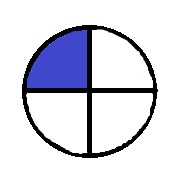5 Understanding Fractions
Introduction to fractions
Fraction: A number of the form which represents part of a whole, or a portion of a group.
[latex]\large\dfrac{a}{b}[/latex]
a = numerator, the top number in a fraction
b = denominator, the top number in a fraction. It shows the total number of equal parts the item is divided into.
 1 whole part ([latex]\frac{4}{4}[/latex])
1 whole part ([latex]\frac{4}{4}[/latex])
 1 quarter part ([latex]\frac{1}{4}[/latex])
1 quarter part ([latex]\frac{1}{4}[/latex])
 2 quarters = 1 half part ([latex]\frac{1}{2}[/latex])
2 quarters = 1 half part ([latex]\frac{1}{2}[/latex])
 3 quarters ([latex]\frac{3}{4}[/latex]) of a whole part
3 quarters ([latex]\frac{3}{4}[/latex]) of a whole part
Add fractions

This diagram is of 4 quarters, in fractions it looks like:
[latex]\frac{1}{4}+\frac{1}{4}+\frac{1}{4}+\frac{1}{4}=\frac{4}{4}=1\text{ whole part}[/latex]
(They all have common denominators, so its easy to add, because all the pieces are the same size.)
Let’s look at a more uneven diagram.

Adding [latex]\tfrac{1}{10}[/latex], [latex]\tfrac{2}{10}[/latex], [latex]\tfrac{3}{10}[/latex], and [latex]\tfrac{4}{10}[/latex], we get [latex]\tfrac{10}{10}[/latex] or 1 whole.
When the denominators of two or more fractions are the same, they are common denominators.
To add or subtract fractions, the denominators must be the same or common, because the pieces we are adding must be the same size. And, once we have determined what the denominator should be, we use equivalent fractions.
Example
[latex]\frac{1}{3}+\frac{2}{5}=[/latex]
To answer this question, the denominators need to be the same or common.
These fractions are all equivalent fractions:
- [latex]\frac{1}{3}=\frac{2}{6}=\frac{3}{9}=\frac{4}{12}=\frac{5}{15}[/latex]
- [latex]\frac{2}{5}=\frac{4}{10}=\frac{6}{15}[/latex]
In the case of [latex]\frac{1}{3}+\frac{2}{5}[/latex], here are equivalent fractions that will give us common denominators:
- [latex]\frac{1}{3}=\frac{5}{15}[/latex]
- [latex]\frac{2}{5}=\frac{6}{15}[/latex]
This is because
- [latex]\frac{1}{3}\times\frac{5}{5}=\frac{5}{15}[/latex]
- [latex]\frac{2}{5}\times\frac{3}{3}=\frac{6}{15}[/latex]
We chose 15 as the common denominator because it is the lowest common multiple for both 3 and 5.
Thus, [latex]\frac{1}{3}[/latex] becomes [latex]\frac{5}{15}[/latex] and [latex]\frac{2}{5}[/latex] becomes [latex]\frac{6}{15}[/latex]
So, [latex]\frac{1}{3}[/latex] + [latex]\frac{2}{5}[/latex] becomes [latex]\frac{5}{15}[/latex] + [latex]\frac{6}{15}[/latex] = [latex]\frac{11}{15}[/latex]
What we are really doing is taking our thirds and cutting them into fifths, giving fifteenths, and taking our fifths and cutting them into thirds also giving fifteenths.
Reduce fraction to lowest terms
Once we have a sum or difference, we attempt to reduce the new fraction to the lowest terms when possible. For this, we need numbers or factors common to the numerator and the denominator.
To reduce a fraction to the lowest terms, divide the numerator and denominator by their Greatest Common Factor (GCF). This is also called simplifying the fraction.
Method: take the difference between the numerator and the denominator. Now state all the factors of this difference and eliminate all those which cannot divide evenly into both top and bottom. The factors that do remain are the only ones that can reduce the fraction.
Example
Reduce [latex]\frac{39}{65}[/latex].
- [latex]65-39=26[/latex]
- Factors of 26 are 1, 2, 13, and 26.
- 26 and 2 are both even and cannot divide into odd numbers.
- The number 1 doesn’t reduce any numbers.
- The number or factor remaining is 13
[latex]\frac{39}{65}\div\frac{13}{13}=\frac{3}{5}[/latex]
For example: Take two integers, 2 and 3.
Multiples of 2: 2, 4, 6, 8, 10, 12, 14, 16, 18, 20….
Multiples of 3: 3, 6, 9, 12, 15, 18, 21, 24, 27, 30

